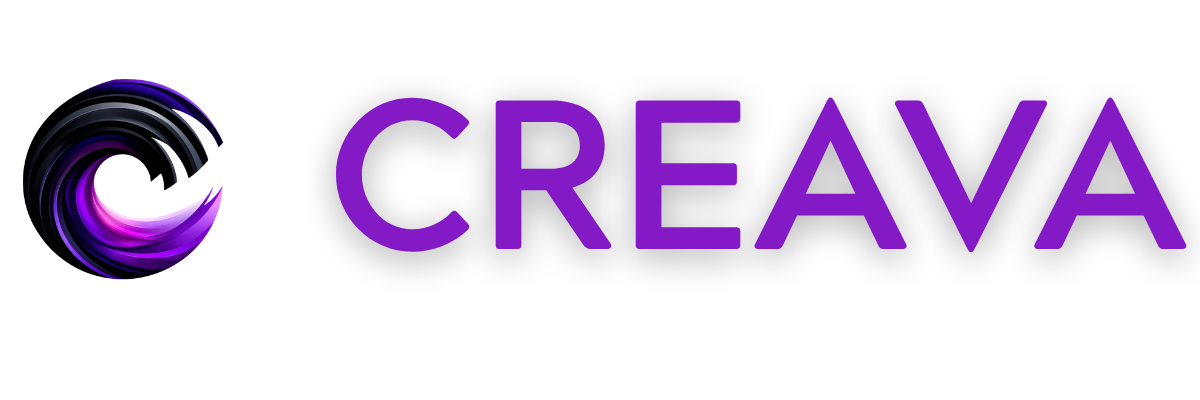From Vision to Render: Exploring Zaha Hadid Through Midjourney and the Beginner’s Lens
Explore how Zaha Hadid’s visionary curves meet AI precision in photorealistic Midjourney renderings. A guide to capturing architecture’s spirit through the beginner’s lens.
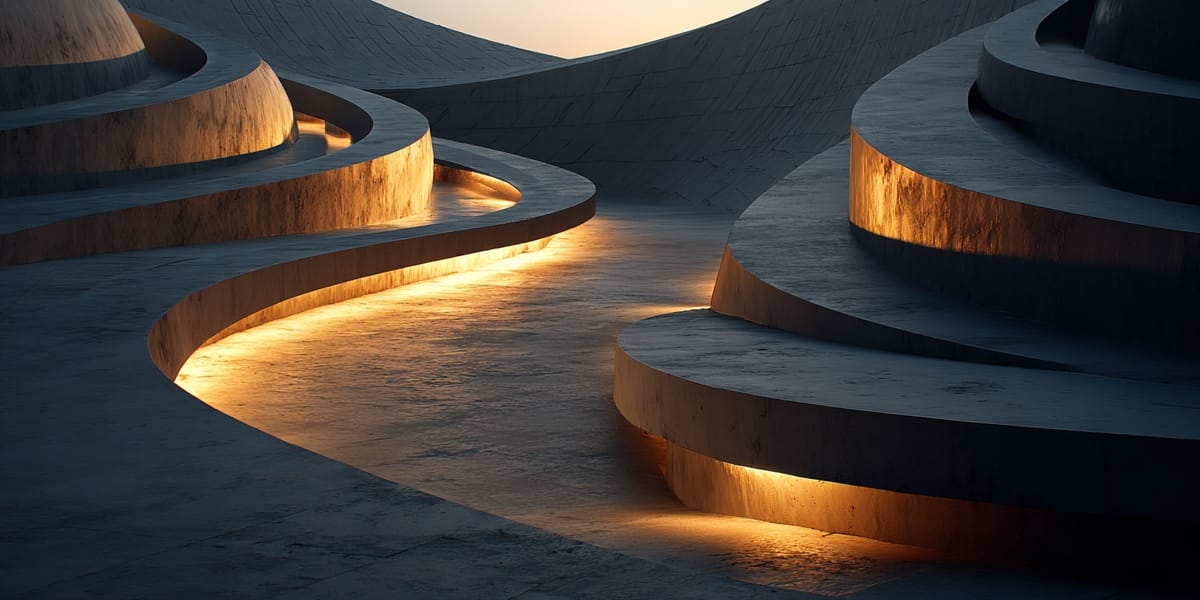
🏛️ Zaha Hadid – Reimagining Architecture’s Boundaries
Zaha Hadid didn’t just design buildings.
She defied them. She bent the rules of gravity and geometry.
She made space, that stubborn and fixed thing, flow like water.
Born in Baghdad in 1950, Hadid saw the world not as walls and roofs but as curves, sweeps, and motion. Mathematics was her first language. Architecture became her second.
At the Architectural Association School of Architecture in London, she sharpened her technical skills. Yet even as she mastered precision, her vision remained untamed.
Her early drawings were not blueprints. They were works of art. Ink strokes spilled across the page, shaping forms too alive to be contained. These sketches revealed what would become her lifelong pursuit: the liberation of form.
Her studio, Zaha Hadid Architects, carries this vision forward today. The firm continues to produce designs that challenge convention and expand possibility. Each project merges engineering mastery with sculptural grace.
Hadid’s philosophy was simple yet radical. Architecture must be alive. It must stir thought, invite wonder, and provoke emotion. Shelter was never the end. For her, it was only the beginning.
📜 Early Life and Education
Baghdad in the 1950s was a cultural crossroads. Modernist ambition collided with ancient heritage, and this tension shaped Zaha Hadid’s earliest memories. She was born into a progressive Iraqi family that valued education, culture, and curiosity. Growing up in such an environment gave her a wide lens on the world. The contrasts of Mesopotamian tradition and rising modernist architecture became part of her DNA.
Mathematics was her first love. At the American University of Beirut, she studied patterns, logic, and precision. Numbers sharpened her edge. Equations gave her discipline. Yet even in mathematics, Hadid saw more than calculation. She saw form. She saw movement. Later, architecture would become her way of giving that vision shape.
In the early 1970s, she left Beirut for London and enrolled at the Architectural Association School of Architecture. At the AA, she studied under influential figures like Rem Koolhaas and Elia Zenghelis. Koolhaas once described her as “a planet in her own inimitable orbit,” a reflection of her singular approach and refusal to follow trends.
Her student projects revealed her independence early. They were not mere exercises. They looked like landscapes in motion. Bold strokes and impossible geometries spilled across her drawings, which critics dismissed as unbuildable. For Hadid, that word was never an insult. It was a challenge. The impossible simply meant undiscovered.
Her mathematical training became the foundation of her architectural vision. It gave her tools to imagine forms that were both structurally daring and mathematically sound. With this grounding, she could disrupt convention with precision instead of accident. Architecture became her second language, one that allowed her to transform the rigor of mathematics into poetry of space, light, and form.
Today, the Zaha Hadid Foundation preserves this legacy through archives, exhibitions, and education. It shows how her early experiences and education created the language of design that would change architecture forever.
🏙️ Landmark Projects and Design Language
Hadid’s work is kinetic. Even when still, it moves.
Her architecture is not a backdrop. It’s a living presence — bending, twisting, and flowing through space as if caught mid-motion.
Heydar Aliyev Center – Baku
A continuous white wave of fluidity. No corners. No seams. The structure rises from the earth as if pulled by the wind, dissolving the line between building and sculpture.
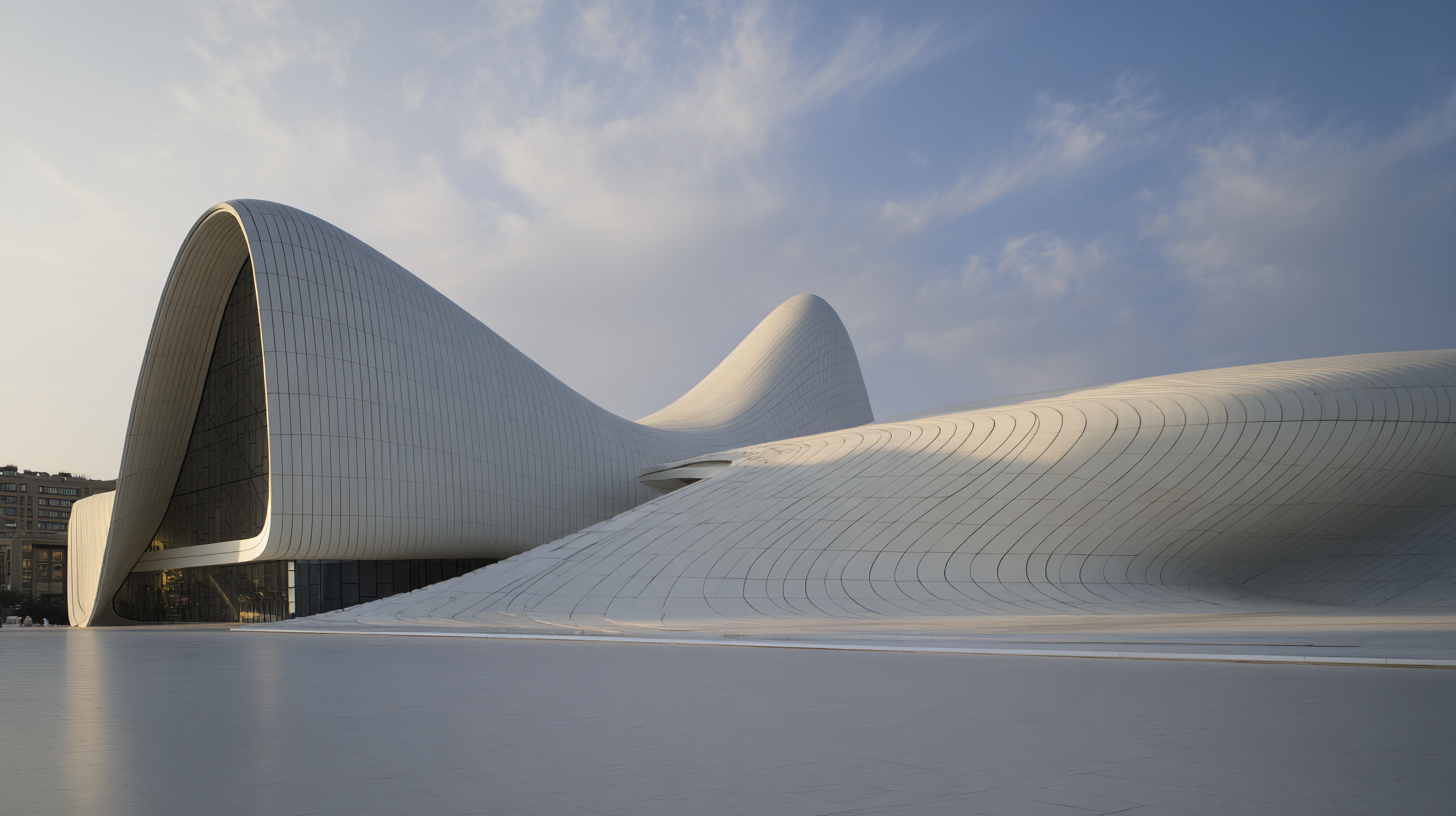
Guangzhou Opera House – China
Sharp angular shells cradle organic interiors. Its form recalls pebbles smoothed by a river, its geometry softened by time and touch.
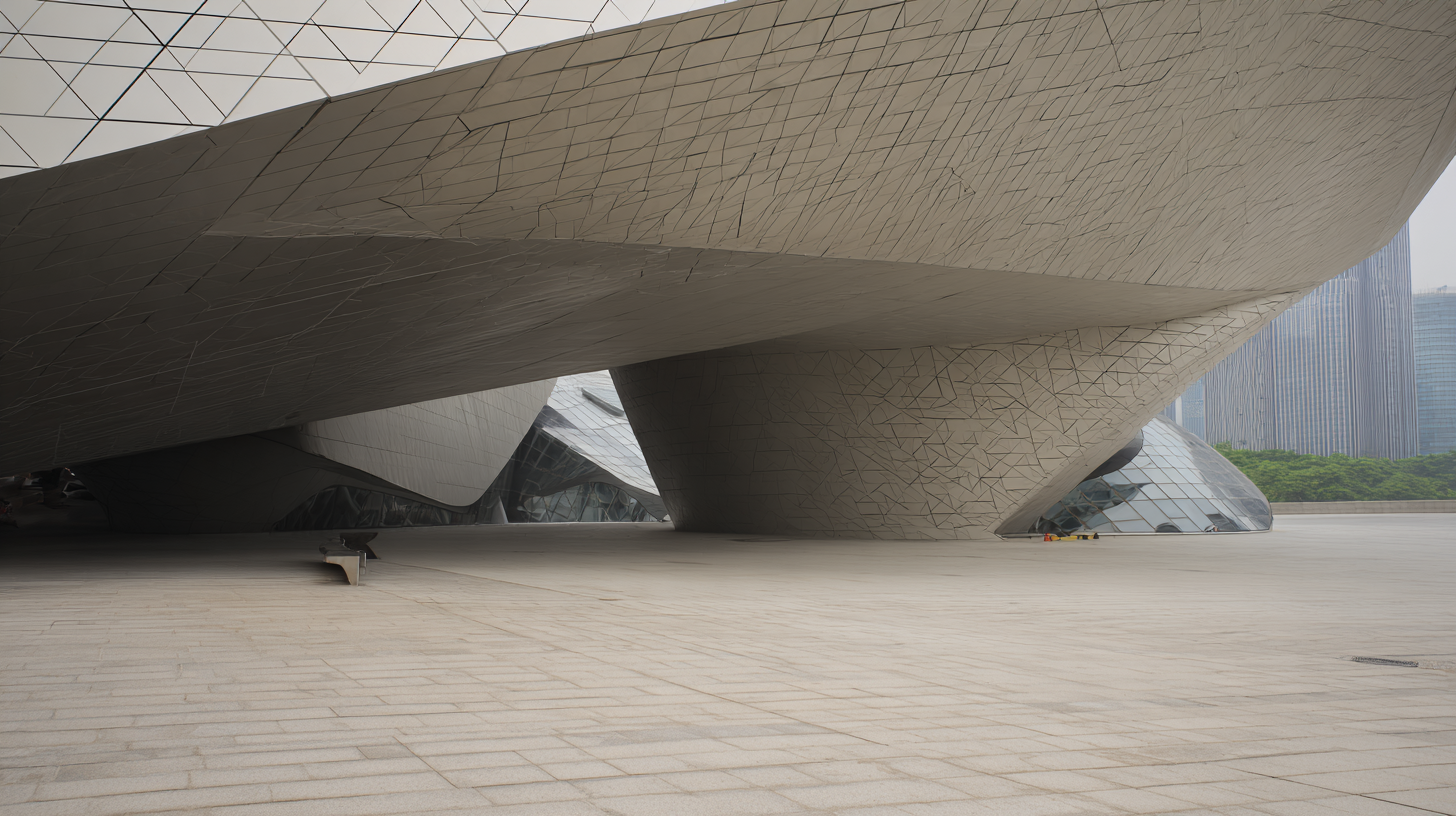
London Aquatics Centre – UK
A roofline that ripples like the water below. Designed for the 2012 Olympics, it captures the spirit of movement and sport in a single sweeping gesture.
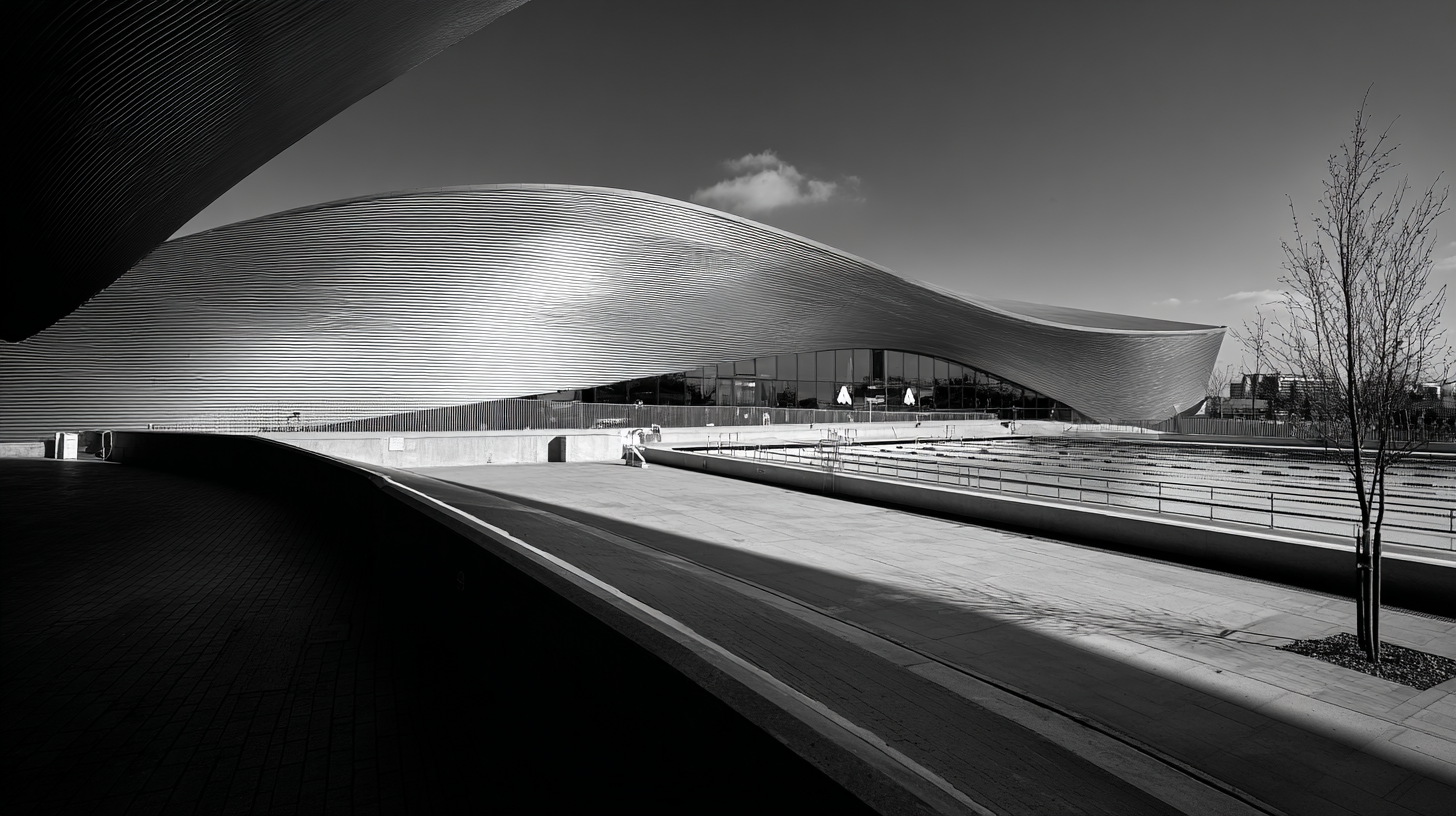
MAXXI – National Museum of 21st Century Arts – Rome
Intersecting ribbons of concrete and glass form Italy’s first national museum dedicated to contemporary art and architecture. Fluid galleries and walkways lead visitors through an unfolding journey.
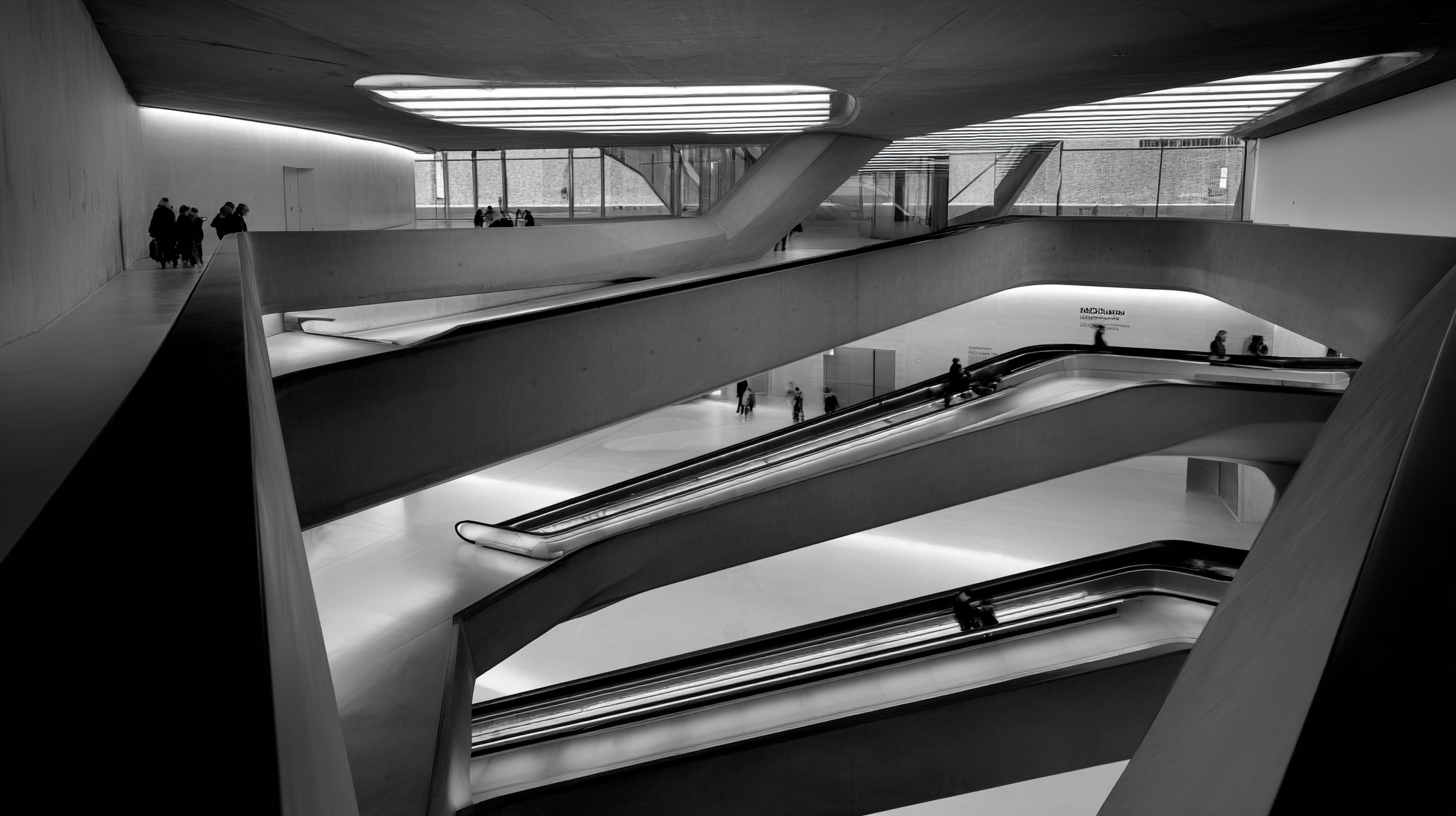
Dongdaemun Design Plaza – Seoul
An undulating, metallic skin wraps around one of the world’s most futuristic cultural hubs. Inside, spaces morph for exhibitions, fashion shows, and technology showcases.
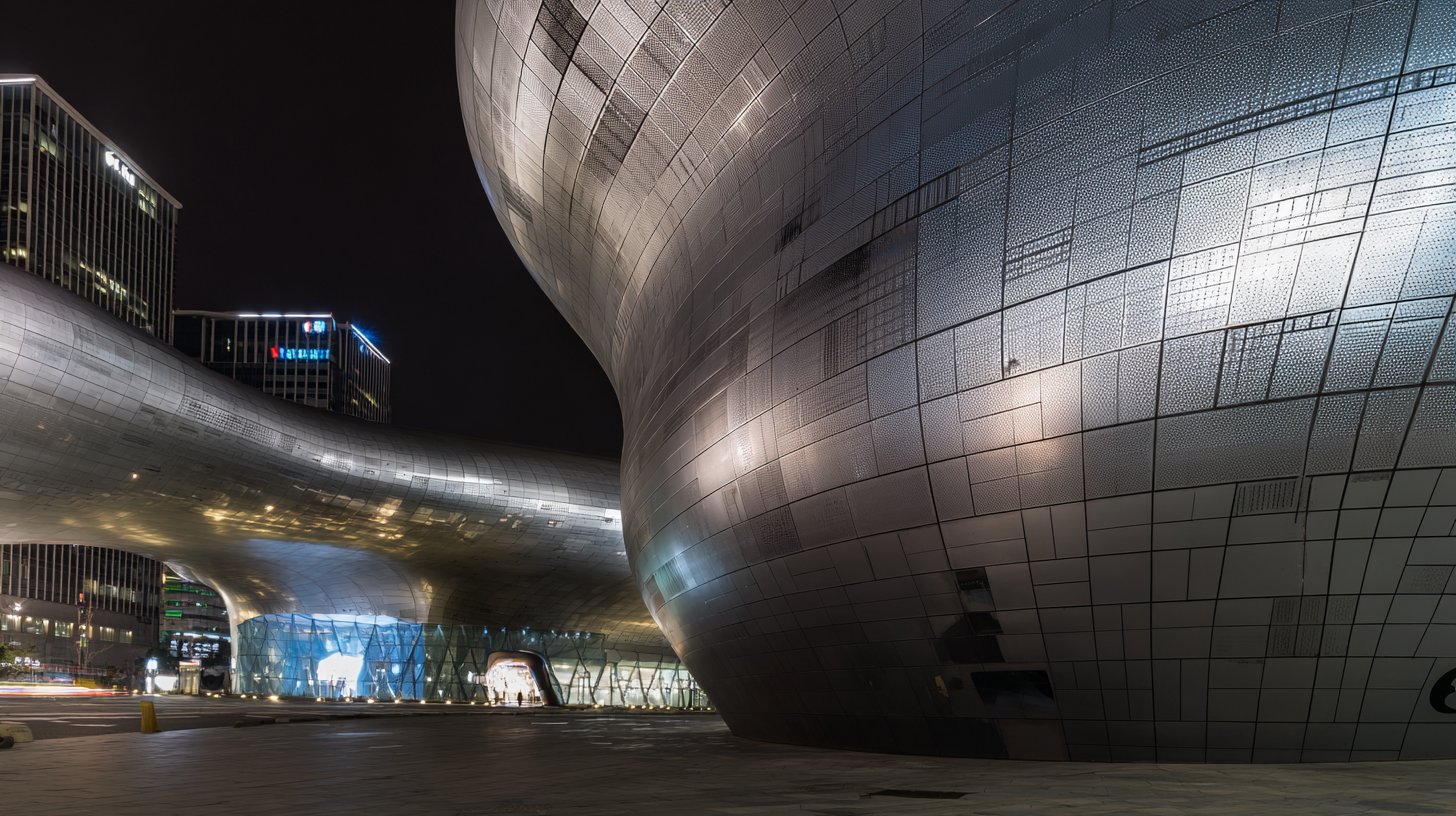
Al Janoub Stadium – Al Wakrah, Qatar
Sails frozen in motion. This FIFA World Cup stadium was inspired by the dhows, traditional Qatari fishing boats, blending cultural heritage with modern engineering.
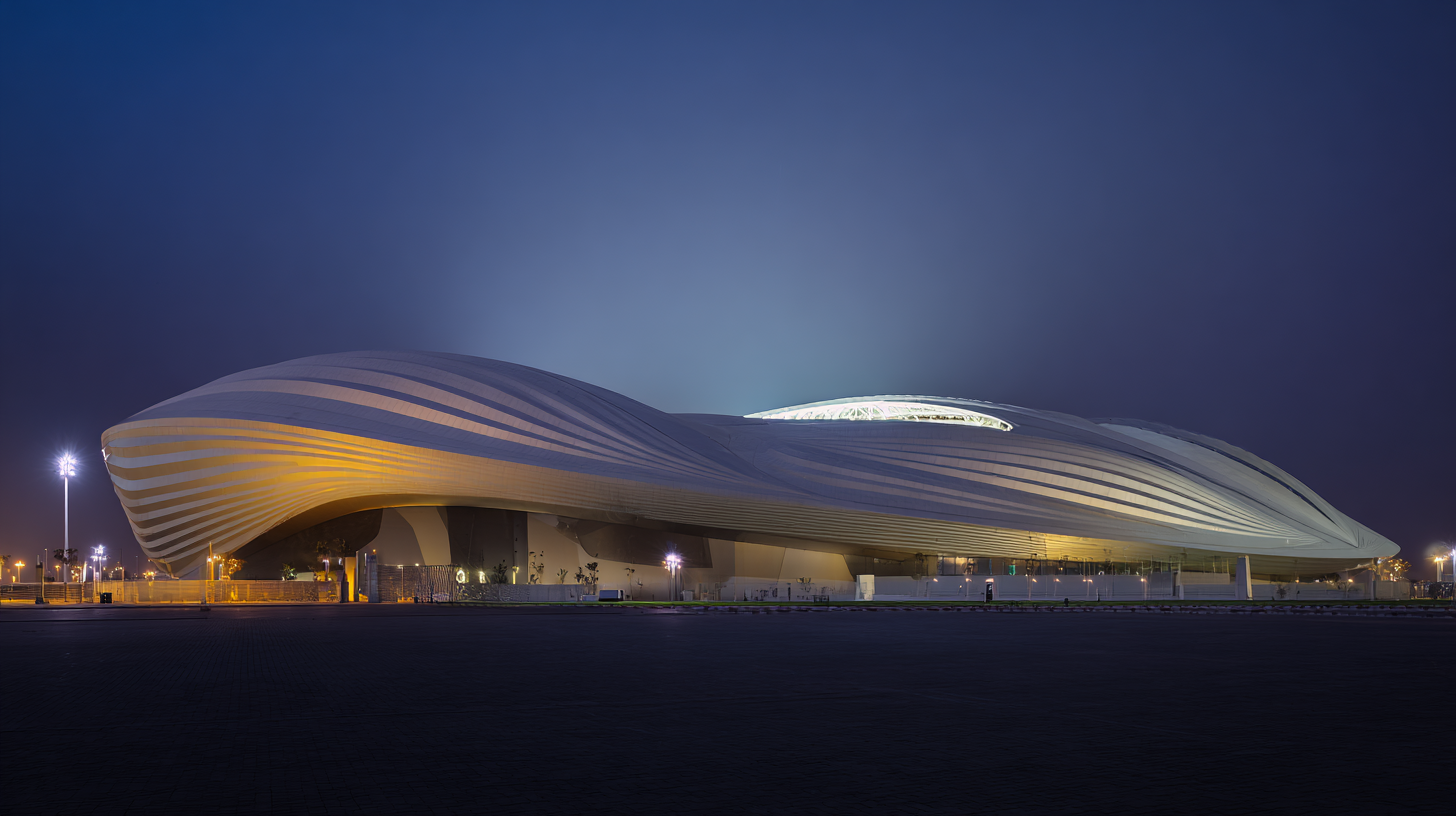
Vitra Fire Station – Weil am Rhein, Germany
Her first built project, the Vitra Fire Station, is a sharp, angular manifesto of her early style, with fractured planes and precise geometry defining a space meant for speed and urgency.
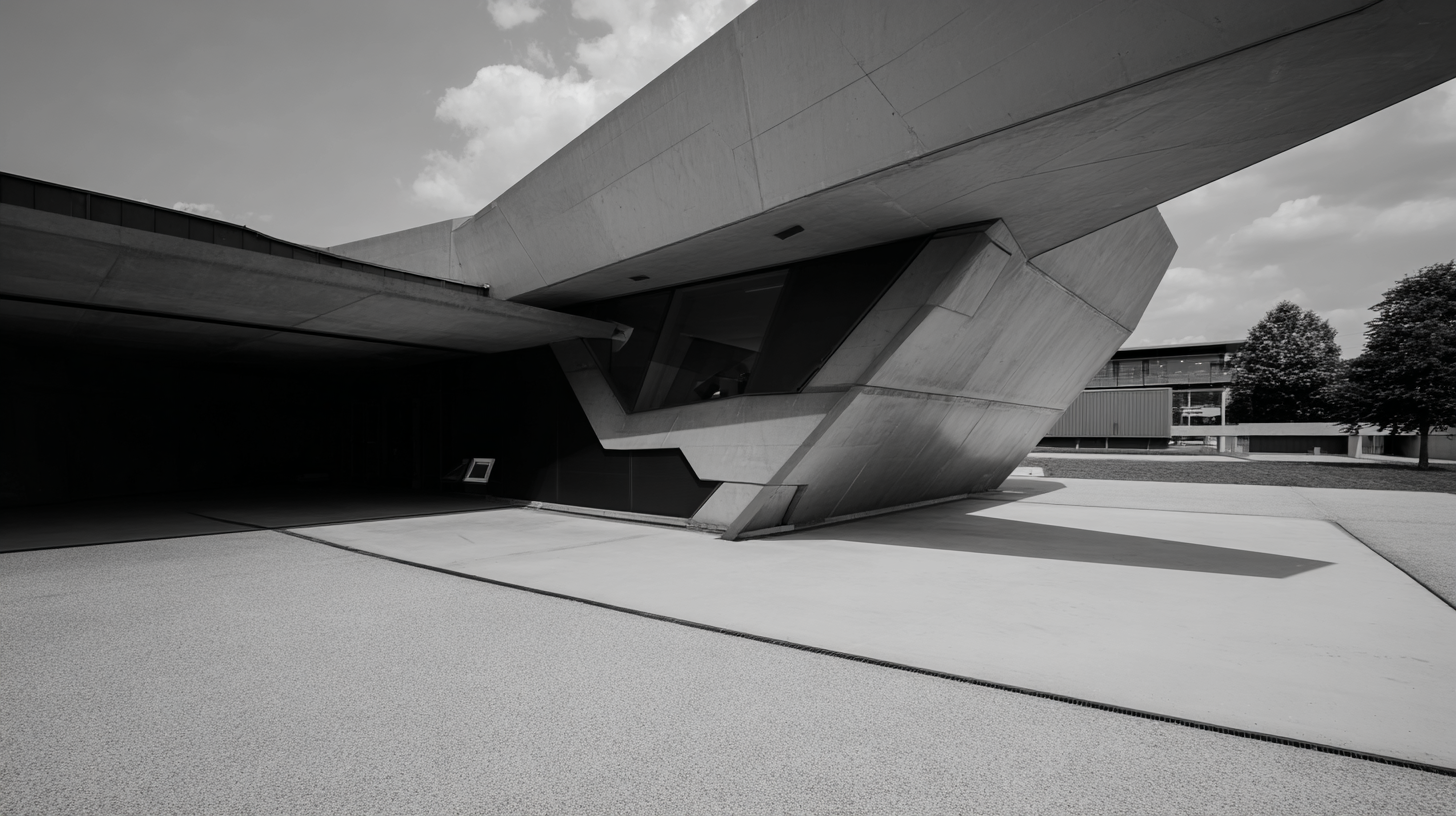
Galaxy SOHO – Beijing
A futuristic business complex of four continuous domes connected by skybridges and courtyards, evoking the seamless flow of organic forms.
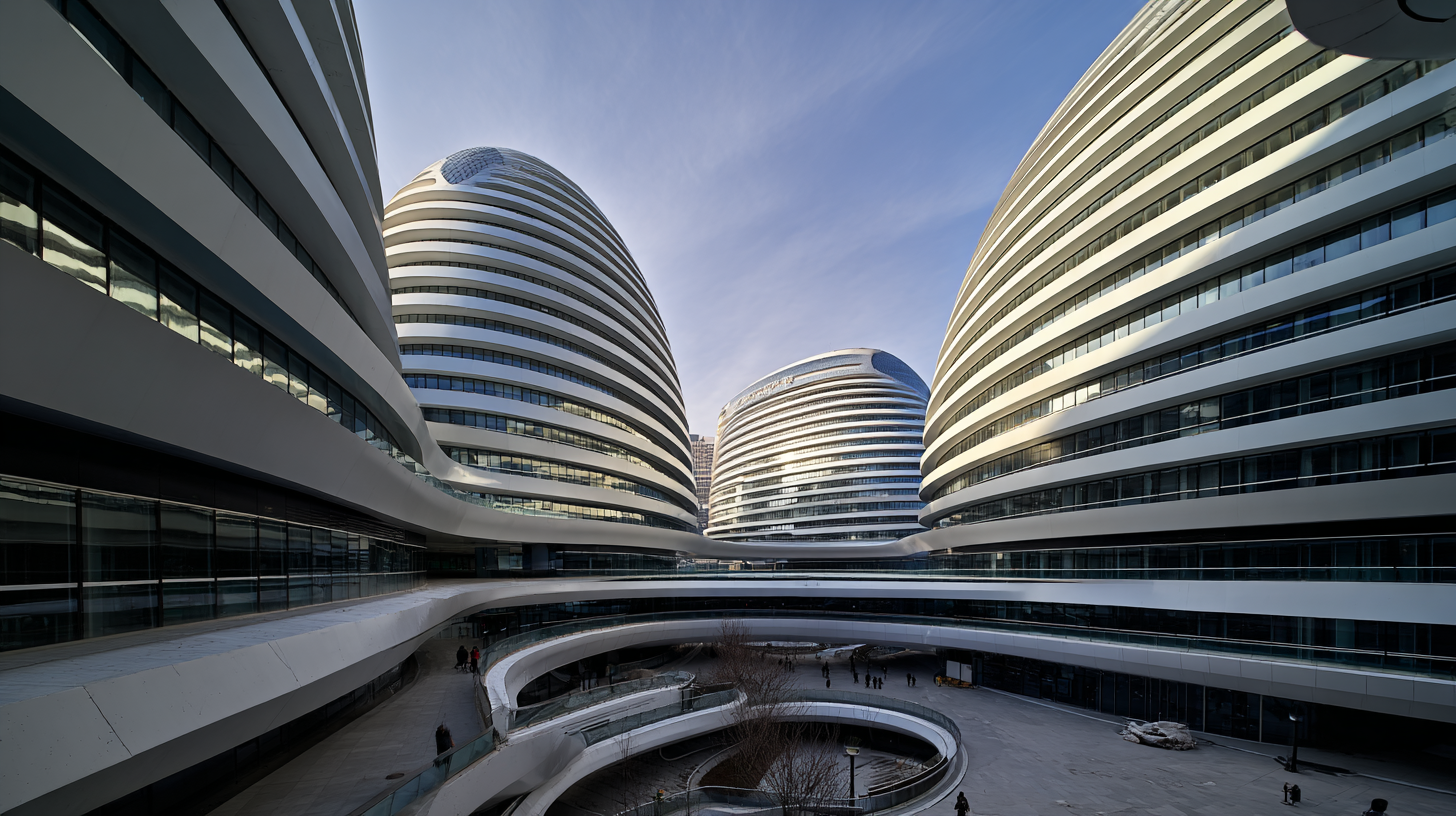
Sheikh Zayed Bridge – Abu Dhabi
Arches that surge and dip like desert dunes in motion, lit at night to create a ribbon of light across the water.
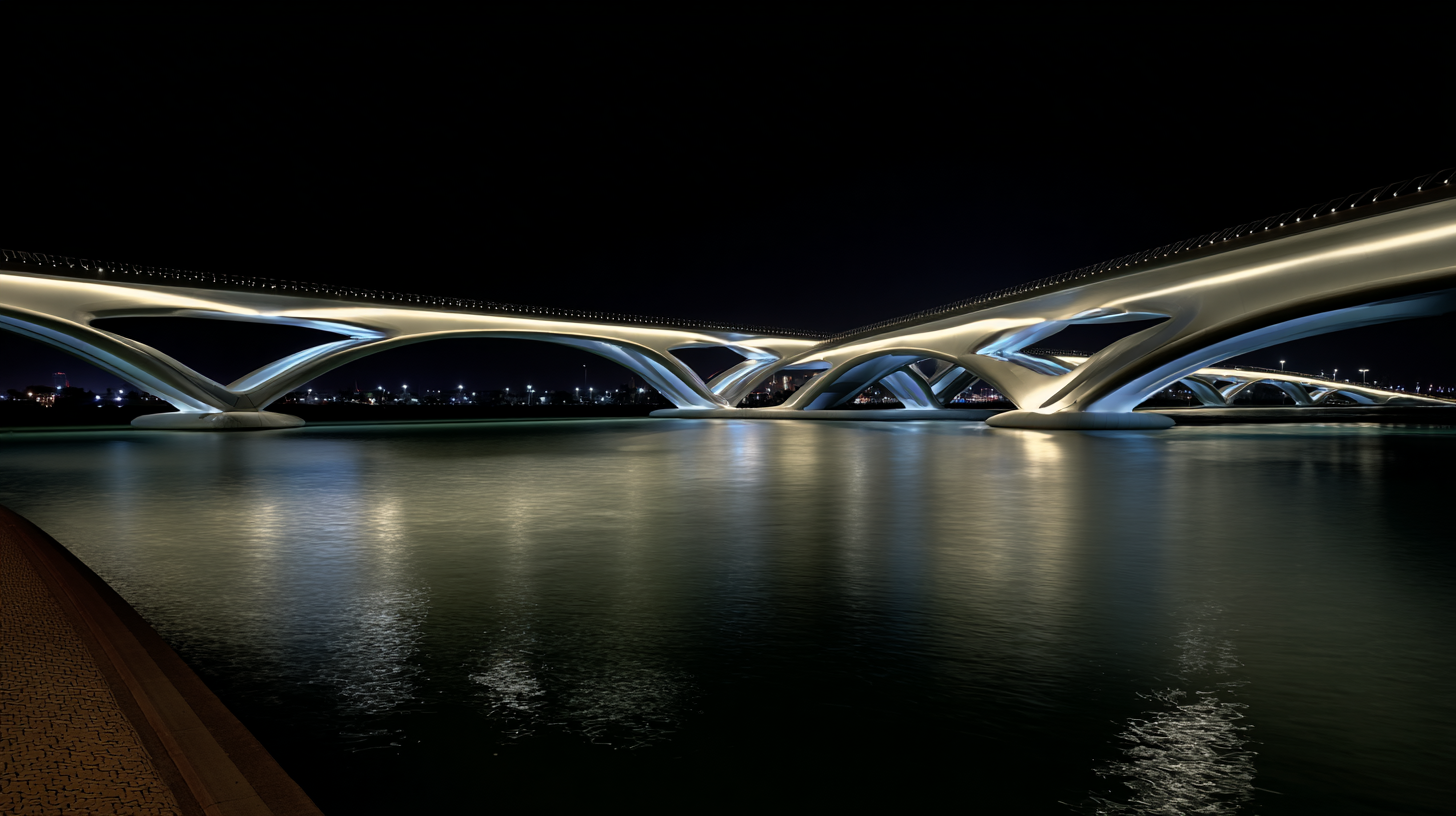
Her portfolio is vast, spanning cultural landmarks to civic infrastructure, all united by a language of movement, fluidity, and defiance of convention.
Explore the full portfolio of her iconic works on the official Zaha Hadid Architects page.
Each project is a physical manifestation of motion and emotion. She rejected static symmetry for dynamic balance, allowing every building to feel like a captured moment — alive, breathing, and never truly at rest.
⚖️ Diverging Visions – Where Philosophies Collide and Evolve
Le Corbusier valued order — the precision of the machine, the discipline of geometry, and the industrial clarity of the modernist age. His designs were calculated, almost surgical, in their intention to serve human needs through an organized visual language.
Frank Lloyd Wright, in contrast, worshipped nature — his “organic architecture” sought to root buildings into their environments, shaping forms that felt inevitable rather than imposed. His work celebrated the interplay between landscape, light, and structure.
Zaha Hadid absorbed from both masters, yet refused to be bound by either. From Corbusier, she inherited the audacity to think in bold, commanding shapes — but she shattered the grid, letting form flow and bend with the momentum of an idea. From Wright, she drew an appreciation for organic movement — yet instead of camouflaging into nature, she sculpted entirely new terrains.
Her genius lay in hybridizing philosophies without diluting them. The result was architecture that looked like it belonged to the future but was still anchored in timeless design principles.
For readers who want to trace these threads of influence, revisit our From Modernism to Midjourney: Reimagining Le Corbusier Through AI post for Corbusier’s disciplined vision, and our Midjourney Meets Wright: AI, Architecture, and the Soul of Design post for Wright’s nature-bound legacy.
To dive deeper into Hadid’s body of work and her archives, explore the Zaha Hadid Foundation’s Architectural Archive — a living repository of drawings, models, and designs that chart her journey from the “unbuildable” to the unforgettable.
📷 Capturing Vision with the Canon Rebel EOS T7
Before you can reimagine architecture through AI, you have to understand it in the real world. The Canon Rebel EOS T7 is that bridge — a camera that connects what you see with what you can later transform in Midjourney.
Lightweight enough to carry on long explorations, yet capable of producing professional-grade detail, the T7 gives you flexibility without intimidation. It’s the kind of camera that doesn’t just grow with your skills — it encourages them. Whether you’re capturing the sweeping curves of the Heydar Aliyev Center or the sharp, fractured skin of the Guangzhou Opera House, this camera translates vision into images with precision.
By learning to capture the subtle shifts in light and perspective in-camera, you create a richer visual library — one that will make your AI prompts far more convincing and nuanced.
🛠️ Why the Rebel EOS T7 Fits a Beginner’s Mindset
A beginner’s mind isn’t naïve — it’s fearless curiosity. It’s the willingness to explore without the weight of “should” and “can’t.” This is the same spirit that drove Zaha Hadid to sketch buildings others called “impossible” — she didn’t start with limits, she started with ideas.
The Canon Rebel EOS T7 nurtures that same exploratory spirit. Its Auto mode acts like training wheels, letting you focus on composition and framing before diving into the technical details. Once you’re comfortable, Manual mode becomes your playground:
- Adjust the ISO to capture shadowed interiors or bright exteriors without washing out detail.
- Experiment with aperture to shift the depth of field — isolating a single sculptural curve or keeping an entire skyline in focus.
- Play with shutter speed to freeze motion for crisp precision or extend exposure to turn moving lights and people into abstract streaks of energy.
This process builds more than technical skill — it cultivates visual intuition. Over time, you’ll start predicting how light will hit a building at a certain hour, or how changing your angle will alter the story of your shot.
That instinct is what transforms AI prompting from mechanical commands into visual storytelling. Instead of typing “modern building, sunset”, you’ll find yourself crafting prompts like: “organic Zaha Hadid-inspired curves, bathed in warm low-angle golden hour light, ISO 200 depth, cinematic shadows”. The difference isn’t just in accuracy — it’s in the emotional resonance the image delivers.
🧪 Parameter Study — How the Prompt + Stylize + RAW Shape the Image
Base prompt:
organic Zaha Hadid-inspired curves, bathed in warm low-angle golden hour light, ISO 200 depth, cinematic shadows
What each clause is doing
- “organic Zaha Hadid-inspired curves” → pushes geometry toward ribboned, fluid, parametric surfaces. Expect sweeping lines, voids, and continuous skins reminiscent of Hadid’s parametric design ethos.
- “warm low-angle golden hour light” → sets the color temperature and directionality. Delivers long shadows, intense edge highlights, and rich copper/gold tones.
- “ISO 200 depth” → implies a clean, low-noise daylight exposure with believable depth-of-field. Midjourney maps this to subtle photographic realism cues.
- “cinematic shadows” → increases contrast and occlusion. Strong key-to-fill ratio, sculpted gradients, and an almost film-still mood.
Stylize (--stylize / --s) spectrum
(what changes as stylization drops across the screenshots)
- High s (250 → 200) → More interpretive, ornamental detail, exaggerated curvature, heightened drama. Color pushes warmer, highlights stretch longer, and forms sometimes verge on surreal.
- Mid s (150 → 100) → The “balance point.” Geometry obeys the brief, materials read more clearly, and lighting behaves more like a real-world set.
- Low s (50 → 0) → Literal, restrained, and architectural. Minimal AI flourish. Edges, scale, and textures feel physically buildable — ideal for design verification.
RAW style (--style raw) and why it matters
RAW strips away Midjourney’s default “house style” (over-glossy contrast, heavy stylization, and automatic embellishment).
With RAW:
- Surfaces stay closer to the prompt’s intent.
- Lighting behaves more like a camera would capture it.
- Textures avoid that “plastic” feel and render more honest material behavior.
RAW + high s (250/200) → Still expressive, but with believable material logic.
RAW + mid s (150/100) → Sweet spot for photoreal yet poetic.
RAW + low s (50/0) → Near-photographic output — best for clients and portfolios.
🖼️ Set 1 – Stylize 250 vs 200 (RAW on)
What changes from s250 → s200
Form
At s250, Midjourney is at its most expressive — the curves become bold, almost cinematic ribbons of architecture. Negative spaces (the voids between the forms) grow larger and deeper, creating a sense of drama and fluidity that feels more like a sculptural installation than a real building. These sweeping gestures can inspire concept art or visionary competitions, but they sometimes push beyond what’s feasible to build.
At s200, the AI reins in these flourishes, keeping the fluid language but tightening spans so they could plausibly stand in the real world. Curves transition more naturally into vertical supports, and cantilevers feel balanced rather than extreme. You still get movement in the architecture, but it’s movement that an engineer could nod at without wincing.
Light & Color
s250 amplifies the emotional impact of golden hour. Amber tones saturate, highlights stretch further across surfaces, and shadows become long, theatrical strokes — almost like a stage set caught in a spotlight. This exaggeration can be incredibly effective for marketing visuals or competition boards where mood is more important than realism.
s200 keeps the same time-of-day feel but restores a more natural tonal balance. Midtones return, gradients smooth out, and the transitions between light and shadow feel more like something you’d capture with a DSLR. It’s still warm and inviting, but now the light behaves with the quiet subtlety of the real world, letting materials and form share the stage.
Surface
In s250, surfaces often take on an idealized, sculpture-like finish. Textures are smoothed or softened, prioritizing silhouette and overall gesture over material authenticity. This can make renders feel dreamlike but less tied to tangible construction.
By contrast, s200 starts to reintroduce material reality. Fine-grained concrete shows its pores, brushed metal reveals directional striations, and even subtle imperfections catch the light. This is where architectural storytelling deepens — a viewer can imagine touching the building, knowing exactly what it would feel like under their hand.
Composition
s250 thrives on drama. Camera angles lean toward near-abstract framing, focusing on bold swathes of light and shadow. Pathways and entrances might be implied but not always fully legible — the emphasis is on artistic impression.
s200 still embraces artistry but makes navigation and scale clearer. Entrances are more obvious, circulation routes read cleanly, and human scale emerges without losing aesthetic punch. This shift is crucial when you want an image that’s as useful to a builder or client as it is to a social media audience.
Takeaway:
Use s250 for “museum-poster” drama.

Drop to s200 when you need “design magazine cover” realism without losing poetry.

🖼️ Set 2 — Stylize 150 vs 100 (RAW on)
What changes from s150 → s100
Form:
At s150, the architecture still indulges in a touch of flourish. Curves may sweep a little more than engineering strictly requires, overhangs might extend for the sake of drama, and voids can open in ways that feel sculptural rather than purely functional. This doesn’t mean the geometry is implausible — it’s just performing for the camera. Think of it like a concept car: technically possible, but not yet constrained by the cost of steel or the physics of wind load.
Drop to s100 and the design language shifts toward buildable geometry. Spans between supports become proportionate to real structural capacities. Overhangs shrink to a level that’s believable under code compliance. Curves are still present — this is Hadid-inspired, after all — but they resolve into arcs and surfaces that feel like they could be poured, panelized, or fabricated without rewriting the laws of physics. This level of control makes s100 renders valuable not only for selling a design, but also for developing it into something that could pass a structural engineer’s desk.
Light & Color:
At s150, golden hour is a little more like a dream sequence. The warmth is slightly exaggerated, leaning into richer ambers and coppers, which enhances the drama of the curves. Shadows stay deep and painterly, falling off in a way that heightens mood rather than mimicking how light would truly decay over distance. This is the kind of light that makes a design look timeless, even if it’s more about emotion than accuracy.
By s100, the lighting behaves much closer to true golden hour chroma — that mix of warm highlights and cool-tinted shadows you get when the sun is low but still strong. Shadow falloff becomes more natural, meaning the transition from light to dark is smoother and more in line with physical optics. Surfaces reveal color shifts based on their material — concrete warms subtly without turning orange, brushed steel catches glints without glowing, and glass reflects with believable clarity. This makes the image feel as though it could have been captured on location by a skilled photographer chasing that perfect late-afternoon light.
Material legibility:
At s150, surfaces often hint at their material nature — brushed metal might catch the light with a soft directional sheen, concrete might show a subtle mottling, but the details stay impressionistic. The goal here isn’t forensic accuracy, it’s mood and elegance.
At s100, the rendering sharpens into specificity. You can see the grain in brushed steel — fine, linear texture that reveals the machining direction. Seams become visible as thin join lines where panels meet, offering a sense of construction logic. Panelization — the deliberate division of a surface into modular sections — reads clearly, helping viewers imagine how the building could actually be fabricated. This shift from “material suggestion” to “material proof” gives s100 imagery a grounded, architectural credibility that clients, engineers, and fabricators can trust.
Camera feel:
Think of s150 as the “hero shot” you’d see in an architecture magazine — everything framed for drama, curves sweeping across the lens, contrast dialed up for impact.
In s100, the camera language becomes that of a DSLR capture:
- Clean exposure — balanced highlights and shadows without overblown whites or crushed blacks.
- Realistic depth of field (DOF) — objects nearer the camera stay tack-sharp, while background elements soften naturally, mirroring how human vision focuses. DOF not only gives spatial depth but also subtly guides the viewer’s eye toward the architectural subject.
- Restrained contrast — tones fall closer to what you’d expect from a real-world, well-calibrated photo, rather than a hyper-stylized image.
The result is imagery that feels like it could have been taken by a photographer on-site, rather than conjured purely in the digital realm.
Takeaway:
s150 gives editorial beauty.

s100 delivers client-ready realism with just enough artistry.

🖼️ Set 3 — Stylize 50 vs 0 (RAW on)
What changes from s50 → s0
Form
At s50, there’s still a faint trace of Midjourney’s artistic hand — subtle curve exaggerations, slightly more graceful arcs than strict engineering might allow. It’s just enough to make the image feel designed rather than purely documented, which works beautifully if you want realism with a touch of polish.
At s0, the AI strips away that final layer of embellishment. The geometry becomes fully grounded in buildable reality — curves obey structural logic, spans make engineering sense, and every joint feels intentional rather than decorative. This is where the image stops “performing” for the camera and starts representing exactly what would be constructed.
Lighting
s50’s glow is still gently romanticized. Edge highlights can be a hair longer, and shadow transitions may hold a softness that flatters the form. It’s the equivalent of a photographer adding just a touch of post-production warmth to make the shot pop.
s0 behaves like a well-metered DSLR capture at ISO 200. Highlights are precise and honest — no over-polished gleam. Shadows fall off naturally according to the geometry and the sun’s position, without any AI-induced bloom or haze. The result feels less like a render and more like a RAW photo straight out of the camera, waiting for real-world editing.
Texture
With s50, Midjourney still smooths surfaces ever so slightly, prioritizing overall composition over absolute fidelity. You’ll get some visible material grain, but it may be softened in favor of a cleaner aesthetic.
At s0, micro-surface fidelity is at its peak. You see everything — the pores in cast concrete, the directional brushing in metal panels, the faint joint lines where facade elements meet. Even subtle weathering or tonal shifts in the material start to appear, giving the architecture a believable, tactile presence. This level of detail is gold for material studies and fabrication reviews.
Vibe
s50 feels like “a designed photograph” — the kind of shot you’d see in an architecture magazine where the photographer’s eye and minor post-processing elevate the subject.
s0 feels like “a photograph of a design” — pure, undistorted documentation. It’s what you’d send to a client, contractor, or planning committee to show exactly what the design is without any interpretive filter. This is the mode for technical accuracy, portfolio truth, and pre-construction alignment.
RAW’s role:
RAW + s0 equals the most camera-accurate rendering Midjourney can produce — perfect for design documentation, client presentations, and construction documents (CDs).


🧩 Quick Guidance — When to Use Which
- Pitch decks / moodboards: s250–200 RAW for maximum visual impact.
- Editorial / portfolio: s150–100 RAW for balance between beauty and plausibility.
- Client pre-visualization (pre-viz) / construction documents (CDs): s50–0 RAW for near-photographic accuracy and trustworthiness.
🌞 Natural Lighting – Harnessing the Sun
Light transforms architecture hour by hour.
- Golden Hour: Warm, soft, embracing curves.
- Blue Hour: Cool, futuristic. Glass turns to water.
- Midday: Sharp, revealing every edge.
Hadid’s designs react to light like sculpture. Shoot at multiple times and you’ll meet multiple buildings.
Understanding how natural light interacts with architecture will help you describe light conditions with precision in AI prompts, yielding more believable renders.
💡 Artificial Lighting – Crafting the Atmosphere
Artificial light puts mood in your hands.
Spotlights carve drama. Softboxes smooth everything. Colored LEDs trace the geometry.
In Midjourney prompts, specify lighting type — “soft cinematic,” “dramatic side-light.” The AI will obey the detail.
Artificial lighting lets you create atmospheres that nature can’t — and AI can amplify those atmospheres into entirely new realities.
🔍 Angles, Perspectives, and Composition in Architectural Shots
Hadid’s forms ask you to move. Bend low. Climb high. Circle until you see the unexpected.
- Close-up: Texture as the subject.
- Wide shot: Building in context.
- Diagonal frame: Static forms that feel alive.
Every angle is a different story. In both photography and AI, composition is emotion.
Your chosen perspective isn’t just about aesthetics — it’s a narrative choice, deciding what the viewer feels first.
🎨 From DSLR to Midjourney – The AI Design Leap
Once you’ve captured reality, Midjourney pushes it into the imagined.
This transition is where art and technology meet — the photo grounds your work in truth, the AI lets it dream.
🖌️ Translating Real-World Shots into AI Prompts
Detail is the language AI understands. Camera, lens, settings, light, mood.
Example:
"Photorealistic rendering of Zaha Hadid-inspired architecture, golden hour lighting, shot on Canon Rebel EOS T7, 50mm lens, f/2.8, ISO 200, sweeping white curves, futuristic glass and steel"

The more exact your language, the more faithfully the AI can transform your vision.
In-depth Prompt & Parameter Analysis
Prompt:
Photorealistic rendering of Zaha Hadid-inspired architecture, golden hour lighting, shot on Canon Rebel EOS T7, 50mm lens, f/2.8, ISO 200, sweeping white curves, futuristic glass and steel --ar 2:1 --raw --stylize 0 --V 7
Photorealistic rendering
Instructs Midjourney to prioritize realism over painterly or abstract styles. Materials, lighting, and depth should match what you’d expect from an actual camera shot.
Zaha Hadid-inspired architecture
Sets the design language: fluid geometry, organic curves, dynamic forms. Expect sweeping, continuous shapes and an interplay of light and shadow over curved surfaces.
Golden hour lighting
Gives warm, directional sunlight — rich amber tones, long shadows, and soft diffused highlights. Enhances curvature and material definition.
Shot on Canon Rebel EOS T7, 50mm lens, f/2.8, ISO 200
- 📷 Canon Rebel EOS T7: Specifies the look of an APS-C DSLR image, which influences tonal range, contrast, and overall sharpness.
- 🔍 50mm lens: Natural field of view, close to human perception. Creates a balanced perspective — not distorted like wide-angle, not compressed like telephoto.
- 🌌 f/2.8: Wide aperture — shallower depth of field, smoother background blur, and greater light intake.
- 🌞 ISO 200: Low noise level, clean details, optimal for daylight scenes.
Sweeping white curves
🎯 Directs form and color palette. White surfaces accentuate golden hour light shifts — subtle warm-to-cool transitions.
Futuristic glass and steel
🏗️ Anchors the material realism. Glass introduces reflections and transparency; steel provides polished or brushed textures for contrast.
Parameter Breakdown
--ar 2:1
📐 Wide cinematic framing — ideal for architectural compositions where you want to capture expansive building facades or sweeping landscapes.
--raw
🎯 Removes Midjourney’s default “house style” — no automatic saturation boosts, no stylized over-embellishment. Output stays neutral and photographic.
--stylize 0
🛑 Disables creative exaggeration — the AI sticks closely to the literal prompt, keeping forms, lighting, and materials grounded in realism.
--V 7
💡 Version 7 of Midjourney’s model — optimized for realistic detail handling, accurate light behavior, and consistent material rendering.
🎯 Enhancing Photorealism with Technical Details
Photorealism lives in the details.
It’s not just “realistic-looking.” It’s the sum of hundreds of tiny cues our eyes instinctively read as truth.
- Depth of field (DOF): The natural blur that happens outside your focal plane tells the viewer’s brain: this was shot through a lens. It creates intimacy in close shots and grandeur in wide shots. In architecture renders, DOF can subtly direct attention to a facade detail, a junction, or the texture of a surface.
- Texture: Concrete pores, brushed metal grain, tiny weathering marks — these micro-surfaces break the sterile perfection of CGI (Computer Generated Imagery) and anchor your render in tactile reality. Leverage high-frequency detail in prompts to ensure AI outputs don’t look too “plastic.”
- Reflections: The way glass catches a low sun. The way brushed steel scatters light into warm and cool streaks. Reflections aren’t decoration — they’re spatial context. They hint at surroundings, climate, and even time of day.
- Atmosphere: Haze, moisture, and airborne particles diffuse light. At golden hour, they give a cinematic softness. At blue hour, they deepen contrast and make glass feel like liquid. Atmosphere can also convey location — humid tropics vs. crisp alpine air.
Key takeaway: The more real your input — lens specs, material types, light physics — the more believable the render. In AI, realism is less about resolution and more about perception cues.
🔄 Balancing Human Creativity and Machine Rendering
AI is the tool. You are the author.
Midjourney can execute with astonishing precision — but it doesn’t have intent. You do.
- Architectural spirit over imitation: Zaha Hadid didn’t design to be photographed. She designed to be experienced. Her works unfold as you walk, turn, and feel the weight of a space. Your AI prompts should reflect that — think about how a person moves through your imagined building, not just how it looks.
- Interpret, don’t copy: The goal is not to recreate Hadid’s exact forms. That’s a shortcut with no story. The real challenge is to absorb her principles — fluidity, structural audacity, light-play — and carry them into speculative futures that she never designed but might have imagined.
- Your vision as the driver: Use AI like a high-end camera in the hands of a director — setting mood, framing intent, controlling every variable to serve your idea. Without your direction, the AI just decorates. With it, the AI becomes a translator for your design imagination.
Key takeaway: AI should be the craftsman. You are the architect of meaning. Design for the lived experience of your visions, not just the screenshot.
🌍 Why Zaha Hadid’s Vision Thrives in the AI Era
Hadid was ahead of her time. AI lets us catch up — and, in some ways, leap ahead.
Her designs were often unbuildable when she conceived them. Materials, construction methods, and budgets all lagged behind her imagination. But today, AI visualization tools let us step into those futures and walk through the architecture she might have designed.
We can now test structural daring without pouring concrete. Rotate buildings in virtual sunlight. See how an unbuilt museum might feel under a winter sky or a summer haze.
AI turns the speculative into the visual — a gift for architects who think decades ahead, not just the next commission.
By reimagining Hadid’s philosophy through AI, we preserve her spirit: designing for human experience, not just for a static image.
🔍 Reimagining the Unbuilt
AI lets us explore concepts that would have stayed trapped in sketchbooks. Hadid’s early work, often dismissed as too radical, now becomes buildable in pixels — giving us a preview of architectural futures.
🕰 Closing the Gap Between Vision and Reality
What once took decades of material innovation can now be tested in hours. AI doesn’t just visualize; it accelerates our ability to validate daring forms in a realistic context.
🧠 Beginner’s Mind as a Creative Superpower
A beginner’s mind doesn’t come preloaded with “impossible.” It asks “What if?” before “Can I?”
This mindset thrives in AI-driven design because the technology itself is still evolving. There’s no fixed rulebook — only exploration. A beginner’s mind will test an idea 10 different ways, simply to see how it might change.
It’s the opposite of “safe” design. Safe design protects known formulas; a beginner’s mind questions them. This is how we arrive at curves that defy grids, facades that shift in the light, and spaces that challenge our sense of scale.
This openness is what allows AI and human creativity to co-create — without one diminishing the other. In practice, it means seeing AI not as a replacement but as a collaborator, capable of amplifying your intent if you remain curious enough to guide it.
🧪 Designing Without a Rulebook
Beginner’s mind thrives in the gray space between mastery and exploration. With AI, each iteration is a laboratory for testing structure, proportion, and emotion in architecture.
🎯 Intent Over Imitation
While AI can mimic any style, a beginner’s mind uses it to push beyond references — making something that feels both new and inevitable.
🏛 The Future of Architectural Storytelling with AI
Architecture has always been about time. Cathedrals took centuries; skyscrapers take years. AI compresses the iteration cycle to hours — letting us explore what would have taken seasons of planning and modeling.
But speed alone is dangerous. It tempts us to chase novelty instead of meaning. Depth comes from layering — texture, atmosphere, narrative, and cultural context. AI can provide infinite options, but it’s the human eye that decides which vision carries the right story.
Think of AI as a time machine for visual storytelling. You can set a building in the fog of a 1920s industrial city, then transport it to a Martian colony at dusk. The best stories will always be the ones that hold emotional weight — and AI can make those meanings visible, tangible, and immediate.
The best architecture images are not the sharpest or the most technically perfect. They are the ones that make someone stop and feel.
📖 Buildings as Narrative Vessels
A great render doesn’t just show a building — it tells a story about the people, the time, and the culture it belongs to. AI expands the settings in which those stories can live.
🌌 From Scene to Experience
AI enables us to create not just architectural forms but atmospheric worlds — where light, material, and space come together in a narrative you can almost walk into.
🔚 Conclusion: A Call to See Differently
Pick up your Canon Rebel EOS T7.
Step outside.
Look for a building you've walked past a hundred times. The one you never really noticed. The one that blends into the noise of the day.
Now stop.
See it as if it’s the first time. Not through routine, but through wonder. See it the way a traveler sees a city waking up. When everything feels unfamiliar, and every detail matters.
Raise your camera. Capture that building. Not for what it is, but for what it could be.
Then take that image and bring it into Midjourney. Let the photograph become something else. Push it into the realm of the imagined. Allow it to evolve.
This is where the future of design begins. Not in software. Not in tools. But in the quiet space between what is and what might be.
That space belongs to you.
It is fluid. It is shifting. It is full of potential.
Artificial intelligence will not replace the human eye. It will not feel for you. It will not choose meaning. But it will help you see more clearly.
It will not design for you, either. Instead, it will offer you hundreds, even thousands, of variations. Options you may never have considered on your own. New directions. New languages of form.
But here is the truth: the designer still leads. The machine offers. You shape. You refine. You breathe life into what would otherwise remain static.
Design is not about accepting the first output. It’s about working until the result speaks. Until it resonates.
The act of seeing differently isn’t rooted in technology. It’s rooted in attention.
That’s where it begins.
Notice the light on a railing at 4 p.m. How it curves, soft and warm, across chipped paint.
Watch how glass swallows clouds. How it reflects the sky one moment and disappears the next.
Observe the slow bend of a shadow across bare concrete. The ordinary, made extraordinary by the angle of your gaze.
These are not just visual moments. They are the raw materials of timeless design.
In this new era, your camera is no longer just a device. And AI is no longer just a tool.
They are collaborators.
The camera anchors you to the real world. It teaches you to observe, to frame, to wait for the right light.
AI, on the other hand, opens the doors to worlds not yet built. It invites you to imagine beyond the edge of what exists.
When you use both with care and intention, your work becomes something more. It carries the weight of reality and the spark of possibility.
It is grounded. But not bound.
This is the future of creative work.
The tools are here. They are waiting in your hands.
The vision lives in your mind.
And the future?
The future is yours to design.
📷 From Lens to Imagination
The camera captures what is real. The lens does not lie. It frames the world as it stands in that moment. Light, shadow, form. Truth frozen in a fraction of a second. That’s the power of photography.
But truth is only the beginning.
What you do with that truth is where the magic begins.
AI takes that captured image and asks a question: What if?
What if the building were made of light?
What if the street turned into a river?
What if this place you know became a place no one has seen before?
This is not about faking reality. It is about expanding it. About using the tools of imagination to stretch the limits of form, texture, and meaning.
Your best work will not exist in certainty. It will live in the tension between what is real and what could be. That space in between is rich with creative potential.
You are not just a photographer. Not just a designer. You are a translator between worlds. Between the now and the not yet.
Use your lens to see clearly.
Use your tools to dream boldly.
Because that is where innovation happens.
🌍 Designing the World You Wish Existed
Do not just document what is in front of you. Do not stop at observation. Go further.
Design futures.
The spaces we live in. The cities we build. The homes we dream of. They all begin with a question: Could it be better?
Architecture is not only structure. It is story. It is vision. It is a way of shaping how people move, gather, rest, and remember. When you take a photo of a building, you are not just recording its walls. You are capturing its possibilities.
And when you bring that image into your creative process, into your renders, your design tools, and your AI workflow, you begin to answer that question.
What kind of world do you wish existed?
Safer. Greener. More fluid. More human.
Each image you create is more than a visual. It is an invitation.
An invitation to see differently.
An invitation to rethink the rules.
An invitation to imagine a version of the world not yet built.
This is the designer’s real job.
Not to replicate. But to envision.
Not to follow. But to lead.
Not to preserve what is, but to propose what could be.
You are not just designing spaces.
You are designing possibilities.
And someone, someday, will live inside what you imagine today.
🖼️ All architectural renderings in this article were created with Midjourney AI, inspired by Zaha Hadid’s design language and crafted for photorealistic detail.
🌟 CREAVA in Practice – Architectural Imagination Meets AI on Fiverr
At CREAVA, we don’t just make visuals. We shift perspective.
Explore my Fiverr profile for services rooted in this same philosophy:
🏗️ Architectural Renderings with Midjourney AI
From Hadid-inspired futures to Wright’s organic ideals, each render becomes a bridge between the built world and the imagined one.
Influenced by the radical experimentation of Le Corbusier, the poetic minimalism of Tadao Ando, and the bold geometry of Bjarke Ingels, these visualizations explore architecture not just as structure, but as rhythm, emotion, and intention.
Whether you are drawn to the modular innovation of Moshe Safdie, the sculptural fluidity of Oscar Niemeyer, the contextual elegance of Peter Zumthor, or the layered futurism of Rem Koolhaas, each image is crafted to express a deeper architectural narrative.
Using Midjourney AI as a creative collaborator, I transform architectural ideas into visual storytelling.
Every detail, from light to material to mood, is shaped by the project’s story, aesthetic, and spatial purpose.
These are not just renderings.
They are design conversations, shaped by atmosphere and vision.
🪑 Interior Design Visualizations
From imagined skylines to grounded brutalism, interiors are reimagined as emotional landscapes.
This is where mood, material, and light converge to shape spaces that feel as real as the ones we live in. Each visualization is designed not just to be seen, but to be felt.
Every scene begins with atmosphere. The soft warmth of golden-hour light across a textured wall. The tension between minimal furniture and bold shadows. These are the details that turn design into emotionally resonant environments.
Drawing from the timeless restraint of John Pawson, the textural richness of Axel Vervoordt, the expressive palettes of Kelly Wearstler, and the architectural clarity of Vincent Van Duysen, each image blends scale, geometry, and storytelling to bring your vision into focus.
Midjourney AI is not just a tool for output. It is a creative lens. A way to explore how form, function, and feeling intersect. Through it, texture, tone, and intention come alive.
From organic modern retreats to urban commercial interiors, every image is tailored to your unique design language and built to support aesthetic direction, client presentation, or creative exploration.
These are not just renderings. They are immersive design experiences, crafted to evoke, built to connect, and always grounded in clarity and concept.
🎨 Moodboards & Concept Art
From fashion to UX design, moodboards and concept art serve as the visual foundation of a brand’s identity. These are not just aesthetic exercises. They are strategic tools that translate abstract ideas into visual clarity.
Each project begins with a question. What does this brand feel like? What colors speak its voice? What textures match its tone? The answers emerge through curated imagery, intentional composition, and a deep understanding of storytelling through design.
Whether you are building a new product, launching a campaign, or reimagining your visual identity, these moodboards act as a creative compass. They align teams, inspire decisions, and guide the evolution of your brand across platforms.
Inspired by editorial design, fashion narratives, digital products, and cinematic storytelling, each board blends form, function, and emotion to create a cohesive visual language.
Using Midjourney AI and traditional design techniques, I craft visuals that capture not just how a brand looks, but how it feels, moves, and connects.
These are more than references. They are creative blueprints designed to unlock vision, fuel innovation, and anchor every decision that follows.
📚 Children’s Storybook Covers
Whimsical, vibrant, and rich with narrative, each storybook cover is crafted to do more than attract attention. It is designed to spark imagination and invite young readers into a world where anything is possible.
A great cover sets the stage. It introduces characters, teases adventure, and creates a sense of wonder before a single page is turned. Whether it’s a tale of talking animals, magical lands, or everyday heroes, the artwork must carry the heart of the story in a single frame.
These covers are inspired by the timeless charm of classic picture books, the visual storytelling of modern animation, and the emotional warmth of handcrafted illustration. Every project blends color theory, composition, and character design to ensure the final image feels both magical and intentional.
Working with Midjourney AI and thoughtful post-production, I develop cover visuals that feel playful, engaging, and narrative-driven. Each design is tailored to reflect the book’s tone, age group, and message, while also standing out on both digital platforms and bookshelves.
These are not just illustrations. They are invitations to imagine, created with care for the children who will carry these stories in their hearts.
Each project begins with curiosity, moves through technical craft, and ends in surprise for both client and creator.
